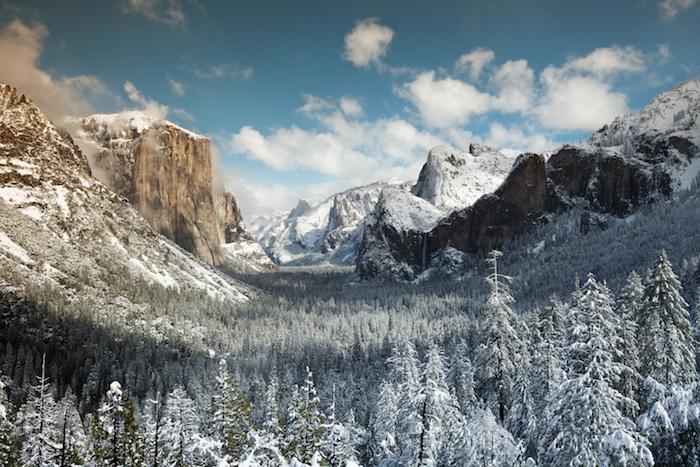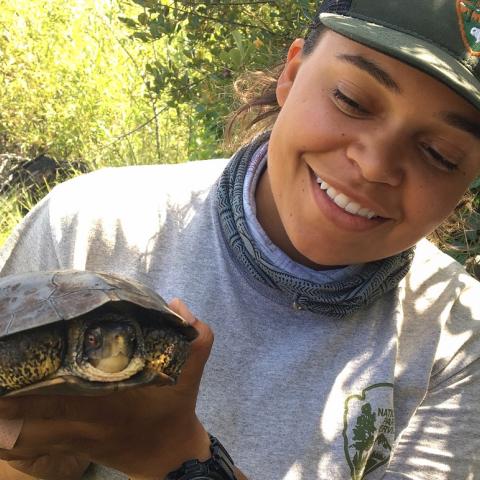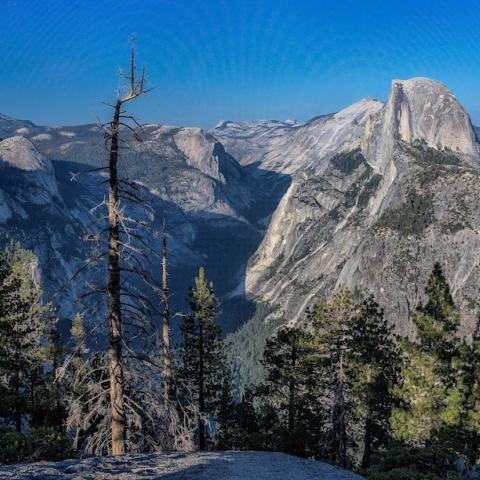Editor's note: The following is advertiser-supported content from Traveler's Essential Park Guide, Winter 2016-17.
There’s one sure-fire way for avoiding the crowds at Yosemite National Park: visit during the winter. Gone until May are the crowds that fill the Yosemite Valley, Glacier Point, and the Mariposa Grove. You’ll love the freedom from take-a-number tourism, and be mesmerized by the pure, clean, quiet whiteness. It just might seem like you have the place all to yourself.
But what can you do in the winter? That’s the easy part. There’s plenty to do; the hardest part might be deciding what to do when you realize you can downhill ski or snowshoe, hike or ice skate, cross-country ski or go tubing. Away from the snow sports, make time to take plenty of photographs, explore historic buildings, watch the sunset on the peaks as you dine in front of a roaring fire, then watch as the sky is taken over by the Milky Way amidst the deep indigo night.
Where to call home during this idyllic season? Head to one of Yosemite’s Scenic Wonders Vacation Rentals at Bass Lake, Yosemite, or Wawona and take advantage of the low rates at this time of year.
That base camp is well-situated for taking advantage of a wide range of activities in Yosemite during the winter months. There are ranger-led full moon snowshoe walks through the big trees. You also can sample local wines at the Vintners’ Holiday, take in a seven-course meal at the Bracebridge Dinner celebration, or find farm-totable fare at Chef’s Holidays. Nothing will make you merrier than spending the year-end holidays in Yosemite.
In the Yosemite Valley, the open-air shuttles that run in summer are replaced with warm tour buses for the winter months, so hop aboard to tour the valley. You can jump off to visit the snowfrocked Yosemite Chapel or walk along the Merced River that cuts the valley, watching for ducks that bob peacefully in the snow-lined waters that reflect the surrounding towers of granite. Rise early and take a morning stroll along the boardwalk at Cook’s Meadow west of the village for a view of Cathedral Rocks. Keep an eye on the giant icicles that form along the park’s waterfalls, as they might crash to the rocks as the sunshine hits them in the morning.
You could spend a morning skating in what is arguably the world’s most beautiful outdoor rink at Half Dome Village. Open since the 1930s, the rink offers fun and opportunity for romance, and its outdoor fire pits help you ward off the cold. The century-old stone LeConete Memorial Lodge, now called the Yosemite Conservation Heritage Center, sits like an ice castle next to the rink. Its steep gable roof and parapets make it an architectural gem.
While the Tioga Road that runs through Tuolumne Meadows isn’t open to vehicles in winter, hardy souls can cross-country ski or snowshoe along its path.
Or you can head up towards Glacier Point and the Yosemite Ski & Snowboard Area, formerly called Badger Pass Ski Area. The ski area offers five lifts, 800 vertical feet, and 10 runs. Though not on par with Squaw Valley, this little ski area that usually sees 300 inches of snow a year has been the training grounds for countless park visitors. There’s also a tubing area and terrain park here, and the access to the backcountry and cross-country ski trails is superb. Bring your skis, or rent, and take a few turns down the mountain, stopping for views and cocoa as often as you wish. You’ll also find 90 miles of marked snowshoe and cross-country ski trails, and 10.5 miles of groomed skating track.
With nearby accommodations in one of Yosemite Scenic Wonder’s more than 100 properties, which are the closest lodgings to the ski area, you can easily catch the day’s first lift to make first tracks after storms.
From the ski area, you can crosscountry ski to Glacier Point. At mile-marker five, look across the canyon to the Clark Range, named for Galen Clark, the first guardian of the Yosemite Grant. The views of the valley, El Capitan, and Half Dome are phenomenal. Across from Glacier Point, Yosemite Falls plummets more than 2,000 feet.

Winter brings a peacefulness to the Yosemite Valley/Scenic Wonders
You could also take a bit shorter snowshoe trip out to Dewey Point, with guides from the Yosemite Conservancy, or head out into Aspen Grove for a self-guided snowshoe hike. There are also two overnight huts accessible from the ski area for the more adventurous, and if you’re visiting in February, don’t miss the Nordic Holiday celebration.
Winter is a wonderfully quiet season in Yosemite, too. That solitude can be hard to fully appreciate while you’re building up a sweat as you kick-andglide or skate towards Glacier Point. But pause to catch your breath. There’s just the sound of a small breeze in the trees, and the beating of your own heart. And don’t head for home without taking in the majesty of the stately sequoia trees at Tuolumne Grove. A short, mile-long ski or snowshoe walk from Crane Flat will lead you into these big trees.
After a day in the forest, on the slopes, amongst the giants, or skiing along the valley’s rim, take the easy 20-minute drive back to Yosemite West and your home for the night. Soothe your body in a hot tub before, or after, sitting down to a well-earned feast. The only decision you have to make is where you plan to go the next day.
Explore at your own pace, enjoy the peacefulness and beauty, and get ready to do it all again the next morning.






 Support Essential Coverage of Essential Places
Support Essential Coverage of Essential Places






